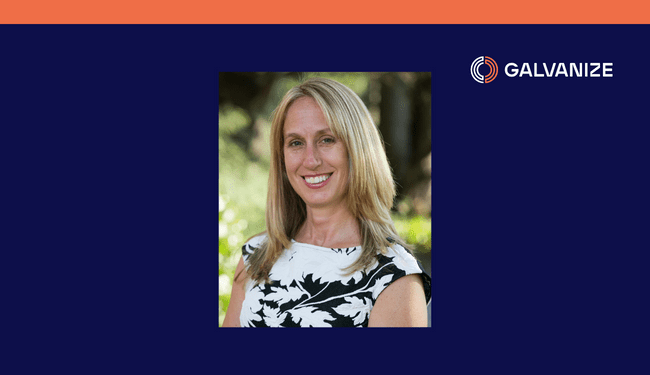
According to a recent study, only 5% of CEOs across the globe are women. Our hope is to see that percentage rise exponentially, and we’re proud to have a woman leading the way here at Galvanize.
In a recent company-wide conversation honoring Women’s History Month, Galvanize Diversity Talent Partner Ashley Bussell interviewed our CEO, Jaime Matyas. They discussed Jaime’s life inside and outside of work, what has and continues to motivate her, her path to leadership, and a lot more. Below, read an abbreviated version of their conversation.
You grew up playing soccer, which you’ve said was formative for you. How so?
I realize retrospectively that playing soccer informed a lot of who I am and how I think about how I do my work. I played starting at age 10, then played all the way through college and afterward.
A great team can achieve things together that they cannot do alone. When I think about a high-performing team, I think about a group of talented people with a diversity of skills, styles, experiences, and backgrounds aligned around a common purpose.
Sometimes, it’s not even about everyone on the team being the absolute best at what they do, but instead, it’s about how the individuals meld and make each other better. I love to be a part of a great team and I am motivated to put in the effort for us to succeed together.
Playing soccer also taught me a bit about representation. When I was in middle school, there was no girl’s JV or varsity team, so a couple of us tried out for the boy’s JV team because that was our only option. Thanks to different groups in the community advocating for a girl’s team, it happened, and then the same thing happened in high school.
This was informative in that it made me realize that you have to advocate for what you want, and it also made me think about who else has an interest in achieving what you want, even if they want it for a different reason. I’ve spent a lot of my career focusing on working toward a desired outcome and working with people who also want that outcome, yet for different reasons.
In your career, did you have women leaders who served as role models for you?
I’ve had the good fortune of having role models, some of which were women, which is why I feel it’s important for me to pay that forward and share the experiences and lessons I’ve learned.
It’s important to invest in mentorship and to create space for others to advance and feel supported as they progress in their careers and through changes in their personal lives.
To me, the best mentorship relationships are when both people are growing and learning. I find these experiences and relationships meaningful, rewarding, and robust.
How did your professional career get started?
I came out of college with an expectation that I was going to know what I was doing next. I was the type of person with the 5-year plan, and a 5-year plan on top of that, and so forth.
Initially, I started by working in New York City at two different sports and entertainment companies in marketing and communications roles. We sold sponsorships, events, licensing, and product endorsements. Success was measured at the end of each month by numbers, so it was a measurable challenge, which suited me.
Over time, I came to feel a difference between being driven and being motivated. It came to a head when, for one of my entertainment clients, we partnered with a children’s hospital, and we proposed improving the common rooms for kids who were in the hospital for long stays due to medical conditions. The rooms felt more depressing than they needed to be, so I worked with the client to remake a common room into a “fun room.”
I was so motivated to work after hours on that project. I started to wonder what it would be like to have the thing that motivated me be the core part of my job, as opposed to the thing I got to do after making my numbers. So I moved into non-profit work. I thought I’d maybe do it for a few years, but it ended up being a 20+ year journey.
To dig into that a bit more, what’s the importance of a central mission in the roles you’ve chosen in your career?
Twenty years ago, mission-driven jobs were predominantly found in government or non-profit organizations. Over the years, that’s changed dramatically.
I believe now that all kinds of organizations can and do create positive impacts on society. The bigger the problem, the more important it is for there to be relationships and collaborations across all sectors.
Galvanize is a special place. Why I was drawn to stay here after serving as interim CEO was that we have the opportunity, by the way we do what we do, to actually expand career opportunities and as a result, change lives. The more we find ways to develop programs that connect people where they are to the technology-related jobs and careers they want to have – and when we do that in a financially sustainable way – we have the opportunity to do more good things for our students, colleagues, and shareholders.
I am drawn at the core to do things that matter and to do things that make a difference. For a long while I focused on organizations. More recently, I’ve come to believe it’s more about positively impacting individuals because individuals go on to do all sorts of amazing things. The more that individuals are equipped to do what they want to do, the more positive impacts they can have on the world.
How do you think about leadership? And how did you get started on your path toward leadership?
The idea of leadership to me is an interesting one. I’d call out a distinction between being a leader and the leader. The leader is about title and role and structure. Being a leader is about how we show up, wherever we are, whoever we are.
The vast majority of the one-on-one conversations I’ve had with colleagues at Galvanize have shed light on leadership all across this company. Leadership is about taking initiative, communicating, and bringing yourself to the situation, even when the situation is tough.
A common theme on my professional journey seems to include identifying needs – either inside an organization or externally with customers, constituents, or partners – and pulling people together to find solutions. In a way, it’s a bit like soccer, where my role was often to go to a space on the field that was not occupied and help create a play. I really enjoy building, creating, and solving problems. It’s easy to identify problems; it’s harder and also opens new leadership opportunities if you can find a way to present both a problem and a possible solution.
As a CEO, have you ever experienced imposter syndrome?
In the quiet, without the crowds, I’ve never had a conversation with another CEO or COO who hasn’t admitted to having imposter syndrome at some point, myself included. The growth edge that I try to have is to lean into the thing that’s scary.
I haven’t found a way to avoid feeling the fear itself, so for me, it’s about not allowing fear or insecurity to inhibit me from trying or doing a thing.
Overcoming fear, insecurity, or imposter syndrome comes from the activity of doing the things I fear and proving to myself that I can.
How do you decompress from work and all its responsibilities?
It’s all about friends and family and physical activity. I have found the most effective way to slow my head is to move my feet. Whether I’m biking or running or hiking, physical activity has always been how I unwind and think. My preference is anything outside.
Working longer and longer hours and not taking time away is not a badge of honor. Many of us need to work hard, sometimes for long stretches of time depending on what we’re doing. But there’s a lot of research on the value of stepping away to a different physical and mental space to allow things to marinate a little bit. If you’re the type of person who gets an idea in the shower, or while you’re cooking or running, there’s a lot of science behind that. Taking time to feed the different parts of your being is important.
Do you have any advice for someone interested in paving their own path toward a leadership role?
There isn’t one right way. We’re all different people. What feels right for me might not feel right for you. I’ve found that I’m most successful when I’m doing things in a way that’s authentic to who I am, so don’t think there’s only one way to be successful in advancing your career.
The other piece of advice I have is that if you’re a person with the ability to influence others, it’s important to give honest feedback in a kind way.
This is a really effective, considerate way of helping people advance. Not giving honest feedback about performance – because you don’t want to hurt their feelings or you don’t want to offend them – I actually think that’s unkind because then they don’t have the opportunity to fully understand what might be holding them back from achieving what they want.
With honest information delivered in a considerate, kind way, you’ll give the person a lot more opportunity to make informed choices about how they do what they do, and you’ll help them get where they want to go.
___
Learn more about Galvanize’s mission and values.
